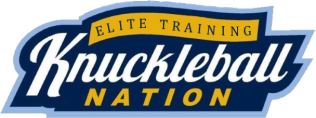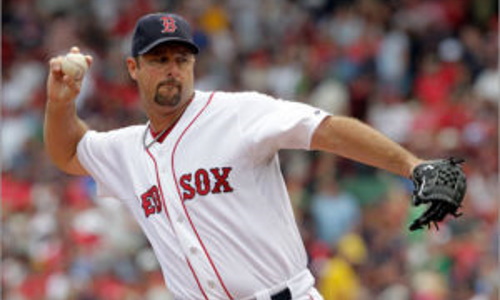There’s a lot of misinformation when it comes to the knuckleball. A lot of people think the pitch is easy because it looks easy on TV, but if you actually try to throw a baseball with no spin off of your fingernails at 67 miles-per-hour then you realize just how difficult that is to do. Simply throwing the ball that hard off your fingertips is difficult and the difficulty increases exponentially when you try to actually kill the spin.
The name of the knuckleball itself is a misnomer. It’s not actually thrown off the knuckles. Instead, it’s thrown off the fingertips with much of the ball thrown off the fingernails themselves. Now, there’s no one right way to hold a knuckleball — if you can kill the spin, then you have a good grip — but there are similarities between the grips of the greats that guide us.
Find Where The Nails Sit
Roll the ball around until you find the logo written at the top of the horseshoe. Curl your pointer and middle fingers to dig your fingernails into the ball along the logo. This is where many legends — Ra Dickey, Charlie Hough and Tim Wakefield — kept their fingertips.
It’s important to use just two fingers and not three or four. Adding fingers only adds to the difficulty of the pitch because you have to maintain equal pressure with all fingers. So, if you have three fingers on the ball, then you’re increasing your difficulty by 150%. If you use four fingers, then you’re making it twice as hard on yourself. So use two.
Notice that the nails may bend as they dig into the ball. You’ll need to file your nails down enough to prevent that from happening. But, if you file your nails down too much, then you won’t have any nail to dig into the ball. So file slowly and carefully until you can dig your nails into the ball without your nail bending. This gives you the strongest leverage and will mitigate the risk of nail breakage.
The Thumb
Do not put your thumb directly underneath the ball. If your fingertips are pressing the ball into your thumb directly, then the ball will spin upon release. The thumb sits more on the side of the ball to guide the ball upon release. You do not want your thumb pushing the ball in any direction or the ball will spin. Of course, your thumb will have to give your fingertips a tiny amount of counterpressure to keep the ball in place in the palm, but it should only be the smallest amount possible.
Ring and Pinky Fingers
The ring finger is critical because, like the thumb, it guides the ball at release and keeps the ball in place in the palm as your throw the pitch. It should sit on the exact opposite side of the thumb — high on the ball near your fingertips — so that the pressure holding the ball in place is fairly equal between the thumb and ring finger.
The pinky finger oftentimes comes off the ball first when the pitch is thrown, so it’s really just in the way. You can hold the pinky off the ball like your drinking English tea or you can rest it on the ball underneath the ring finger. Either way, it barely has an influence on the ball whatsoever.
Deep in the Hand
There are two schools of thought on the depth of the ball. Phil Niekro, a hall of famer, really pushed the ball deep into his palm. The other hall of famer, Hoyt Wilhelm, held the ball loose in his hand with plenty of space between his palm and the ball. The ball kind of floated off his palm while his fingers held the ball like pincers. Either way can work, but know that you’ll have to use a lot of grip tension if you go the Niekro route and a very loose grip tension if you choose the Wilhelm path.
Guys that wedge the ball into their palms like Niekro oftentimes use a stiff wrist to throw the knuckleball. Likewise, the guys that float the ball in their hand like Wilhelm oftentimes use a loose wrist to deliver the ball. The idea being that the hand will naturally grip down on the ball the proper amount as you deliver the ball forward much like a hitter that uses a light grip on the ball.
The only way to see which grip variables work best for you is by trial and error but do not be misled by a small sample size. You’ll have to throw tons of knuckleballs over days and weeks to see the difference because the pitch is so fickle. And remember, it’s not good enough just to kill the spin. You’ll have to control what little spin is on the ball to make it break properly.



